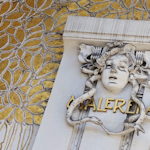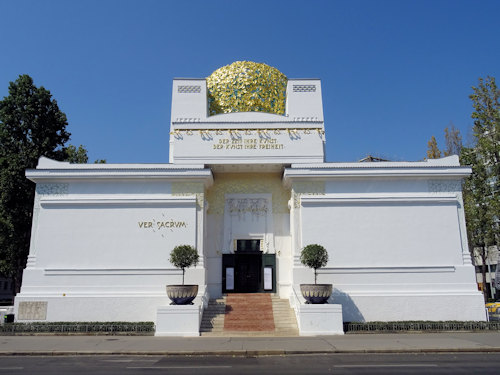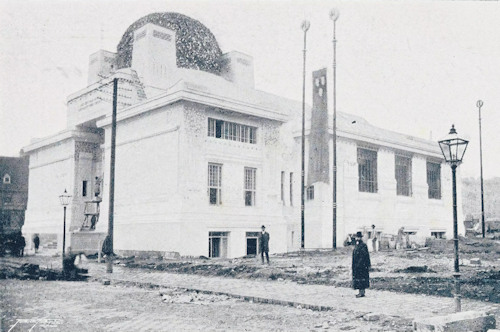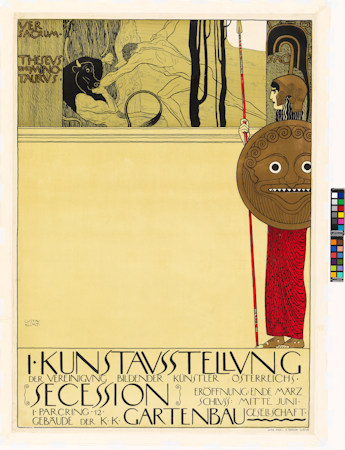
It stands like a golden beacon embraced in white: the Secession building continues a long tradition of contemporary art and also houses one of Klimt’s masterpieces.
- See Gustav Klimt’s Beethoven Frieze
- Close to the Naschmarkt open-air market
- Regular contemporary art exhibitions
- Book a Klimt ticket package
- Major locations with his works
- See also:
The “Secessionsgebäude”

(View of the glorious roof)
The late 1800s and early 1900s must have been quite a time in Vienna.
You had, for example, the tradition of a centuries-old monarchy and a long-serving Habsburg emperor (Franz Joseph I) clashing with a vibrant contemporary art and intellectual scene “led” by the likes of Gustav Klimt.
It’s not a recipe for harmony, though it did give rise to the period of outstanding creativity known as the Wiener Moderne.
Anyway, Klimt and friends broke off from the traditional Künstlerhaus group of Viennese artists in 1897 to form their own organisation with a stronger focus on more progressive contemporary art.
This new association became known as the Secession (the full title was, as so often in Austria, much longer: Vereinigung bildender Künstler Österreichs Secession). And, in 1898, they got their own gallery for exhibitions: the Secessionsgebäude or Secession Building.
(People often use the word “Secession” to refer to both the organisation and the building.)
What’s inside?

(Front view)
Though not one of the “traditional” tourist destinations, the Secession Building still enjoys a lofty status among locals and visitors alike.
First, you have the architecture of the Secessionsgebäude itself, which was fully renovated back in 2018.
Designed by Joseph Maria Olbrich, the building features a white, Jugendstil structure topped by a cupola constructed from 2,500 gilded iron laurel leaves. The architect was one of the founding members of the Secession.

(The Secession around the time of its construction, from a postcard produced by Kunstanstalt Stephan Tietze, Aussig; Wien Museum Inv.-Nr. 231307; excerpt reproduced with permission under the terms of the CC0 licence)
Locals affectionately call the 8.5m-wide dome the “golden cabbage”, though not everyone greeted it with approval back in 1898: one writer claimed the dome led you to think you were facing a Buddhist temple, mausoleum or crematorium.
Second, you have the artistic connections. Klimt’s works appeared here, for example. As did Schiele‘s. And many other pieces of art by famous names of the time.

(Gustav Klimt’s own design for the Secession building from 1898; Wien Museum Inv.-Nr. 115982, excerpt reproduced with permission under the terms of the CC0 licence)
Although Klimt soon parted company with the Secession, the organisation continued until its forced closure under the Nazis. It re-formed under a slightly different full name in 1945 and is still going strong today, hosting contemporary art exhibitions in the galleries within the Secession building.
Quite what you see inside depends, as always, on the current artists or themes on show. When I went, the next two exhibitions were set to feature Moroccan-French visual artist, Bouchra Khalili, and US visual artist, Elaine Reichek.
Once inside, go down some stairs (or take the lift) to find the home of Klimt’s famous Beethoven Frieze. Before you reach the Frieze, an antechamber gives you a brief history of the Secession building (in English), including blueprints, a model and design sketches.

(Poster designed by Klimt for the first exhibition of the Secession in 1898; Wien Museum Inv.-Nr. 129001/2; reproduced with permission under the terms of the CC0 licence)
Tickets & visitor tips
At the time of writing, a single adult ticket (covering both the exhibitions and the Beethoven Frieze) cost €12 with an English audioguide available for €3 (or free with a Vienna City Card).
Now for a few tips:
- You can visit the store without a ticket. On my trip, it stocked a wide collection of art books & catalogues, high-end gifts, and more traditional souvenirs like posters and fridge magnets. Look out for Secession honey made by the bees that live under the golden dome.
- Be sure to take a walk before or afterwards along the Naschmarkt, which begins diagonally opposite the Secession’s front door. This is Vienna’s biggest and best open-air market, full of little bars, restaurants, and a whole host of food stalls. Excellent for grabbing something to eat.
- And if you enjoy turn-of-the-century architecture, then Otto Wagner’s colourful Majolikahaus and his Pavilion at Karlsplatz are both close by.
- For more Jugendstil architecture in Vienna, try my tips for…
- Jugendstil along the pedestrianised Graben
- Jugendstil elsewhere in the centre
How to get to the Secession
The Secession building is right next to Karlsplatz, a major subway station, so is well connected to the public transport system. The U1, U2, and U4 subway lines all stop there. It’s quite a big subway station, so you want to leave the complex to the west. Look for the exit marked “Ausgang Secession”.
Address: Friedrichstraße 12, 1010 Vienna | Website